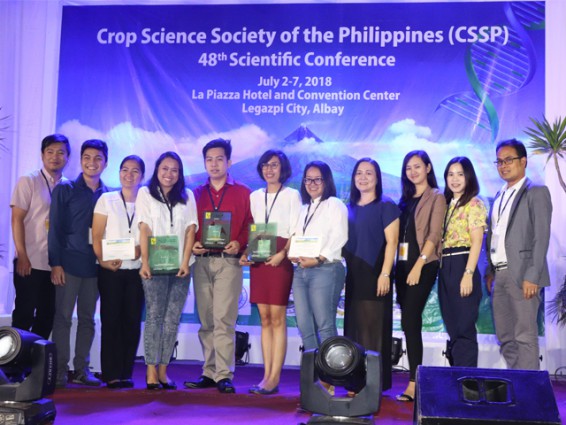Studies on stress-tolerant rice, healthy rices, mechanized inbred rice seed production, novelty rice products, and high-technologies by the Philippine Rice Research Institute (PhilRice) were recognized in a scientific gathering led by the Crop Science Society of the Philippines (CSSP), July 2-7.
In the 48th CSSP Scientific Conference, 14 PhilRice studies were awarded in different categories owing to their importance in advancing agricultural sustainability and development in the countryside.
The study Morphological and Dry Matter Yield of Rice Genotypes in Response to Drought Stress and Rewatering at Vegetative Stage by Gem Faustino, Jose Hernandez, Nenita Desamero, and Rolando Cruz won first place in the Crop Physiology and Biochemistry category.
Through the experiment, 8 out of 17 rice genotypes were spotted to have the ability to withstand drought stress during vegetative stage. Plant irrigation was withheld for 20 days and were rewatered for 10 days with 2-3 cm floodwater depth.
“The slow progression of drought stress indicators such as leaf rolling and leaf tip drying were identified to have helped the plant maintain its water status and photosynthetic ability, thereby withstanding the possible effect brought about by lack of irrigation,” said Faustino, research team member.
For the Postharvest Handling, Processing, and Utilization category, Rodel Bulatao, John Paulo Samin, and Paul Jhon Eugenio also garnered first place for their study Encapsulation of Black Rice Bran Anthocyanin-Rich Extract: Optimization and Characterization.
Anthocyanins are known for their benefits specifically in cardiovascular health, and anti-cancer and anti-inflammatory properties. The team have identified encapsulation as an effective method to optimize the use of anthocyanins in black rice bran.
“The capsules developed in the study had high phenolic content and strong antioxidant activity; making it a promising material for food and pharmaceutical use,” Bulatao said.
Meanwhile, Josefina Ballesteros, El Shaira Labargan, Rosaly Manaois, Amelia Morales, and Riza Ramos won first place for their study Research to Revenue: The Feasibility of Brown Rice Cracker Ice Cream Sandwich (BRICS) in the Technology Extension, Dissemination, Education, and Socioeconomics category.
BRICS contains brown rice and buffalo’s milk. It is a nutritious and energy-dense snack food for 15-30 years old and has high market potential. Results also show that commercializing the product for five years will generate positive net profits and net cash flows with a payback period of 2.4 years.
On the other hand, the Low Protein Rice for Chronic Kidney Disease Patients and Individuals Requiring Reduced Protein Diet study by Marissa Romero, Princess Belgica, Maricar Castillo, Henry Mamucod, Manuel Jose Regalado, and Amelia Morales won first place in the Technology Development category.
Optimization of the process with collaborator Biotech Japan Corporation resulted in appropriate rice protein reduction. It was also found that certain local varieties such as NSIC Rc 304, NSIC Rc 242, NSIC Rc 160, NSIC Rc 222, and NSIC Rc 152 can be used in developing low-protein rice with acceptable quality for consumption.
“In our country where rice is the staple food, reducing its protein content would be an excellent strategy to help patients with chronic kidney disease who require low protein and other individuals with restricted protein diet,” Romero explained.
Below is the list of winners in different categories of the poster competition:
Crop Physiology and Biochemistry
Identification of beneficial endophytic bacteria isolated in talahib (Saccharium spontaneum L.) roots by Krizelle Joyce Jardinero, Jayvee Cruz, Roel Suralta, and Reynante Ordonio (2nd place)
Root developmental response of selected rice varieties under progressive drought conditions by Gian Carlo Gaetos, Cynthia Divina, Sofronio Kalaw, Renato Reyes, Teodora Mananghaya, Jonathan Niones, and Roel Suralta (3rd place)
Crop Production and Management
Income rise with mechanized rice: Higher yield and quality through mechanized inbred rice seed production by Alpha Grace Ferriol, Rachel Ramos, and Susan Brena (2nd place)
Development of an Integrated Crop Management package for rice in saline prone areas for increased productivity by Nenita Desamero, Reynaldo Castro, Anielyn Alibuyog, Glenn de Peralta, Eric Linbergh Inovejas, Sonia Pojas, Luzell Pungtilan, Ahlfie James Galanza, and Jay Rupert Mendoza (3rd place)
Plant Breeding and Genetics
Mass screening of rice under intermittent reproductive drought by Via Ann Marcelo, Jonathan Niones, and Nenita Desamero (2nd place)
Postharvest Handling, Processing, and Utilization
Why do you need to eat your pigmented rice unpolished? by Rodel Bulatao, Reniel Tubera, John Paulo Samin, Charleo Zapanta, Juvy Monserate, and Joel Salazar (2nd place)
Quality characteristics and consumer acceptability of rice: adlai energy bar by Amelia Morales, Rosaly Manaois, Henry Mamucod, Maricar Castillo, Princess Belgica, and Marissa Romero (3rd place)
Technology Extension, Dissemination, and Education/Socioeconomics
Analysis of the value addition and distribution in the rice value chain in the Philippines by Alice Mataia, Jesus Beltran, Rowena Manalili, Nefriend Francisco, Adrielle Flores, and Bethzaida Catudan (2nd place)
Technology Development
Instant GABA rice congee: Not just your typical “Lugaw” by Rodel Bulatao, Maricar Castillo, John Paulo Samin, Ryan Conde, Manuel Joshua Joson, Evadne Veluz, Gerladine Gantioque, and Marissa Romero (2nd place)
Improved rice yield monitoring using remote sensing and crop simulation model by Elmer Alosnos, Eve Daphne Radam, Emma Quicho, Tri Setiyono, Gene Romuga, Jovino de Dios, Eduardo Jimmy Quilang, Mary Rose Mabalay, Arturo Arocena, Juanito Maloom, Jeny Raviz, Alice Laborte, and Massimo Barbieri (3rd place)





